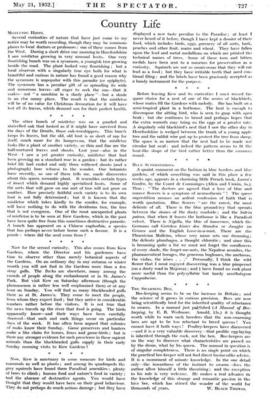The other bunch of mistletoe was on a gnarled and
shrivelled oak that looked as if it might have survived from the days of the Druids, those oak-worshippers. This bunch keeps its leaves, but the old, old host is so short of sap for itself, much more for its hangers-on, that the mistletoe looks like a plant of another variety, so thin and fine are the half-nurtured leaves and shoots. Last year—also in the West--I saw a yet greater curiosity, mistletoe that had been growing on a standard rose in a garden : but its rather brief life had ended and only three withered shoots (and a photograph) bore witness to the wonder. Our botanists have recently, so one of them tells me, made discoveries about this queer, romantic plant. It resembles certain types of insect which demand highly specialized hosts. Some of the sorts that will grow on one sort of tree will not grow on another. How precisely faithful each variety is to its own host is not fully determined ; but it is known that the mistletoe which takes kindly to the conifer, for example, will have nothing to do with the deciduous tree, the tree that is not evergreen. One of the most unexpected plants of mistletoe is to be seen at Kew Gardens, which in the past have been quite free from this sometimes destructive parasite. A bunch has appeared on a Chinese euphorbia, a species that has perhaps never before borne such a favour. It is a puzzle : where did the seed come from ?
• • * •




































 Previous page
Previous page